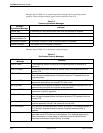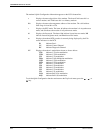
COMSPHERE 3900 Series Modems
3-8 September 1998 3910-A2-GN32-40
Menu Structure
The menu tree is a hierarchical structure used to display functions that configure and control local
and remote 391x Series modems. It is accessed via the DCP and is shown in Appendix A, Menu
Tree.
Configure
Status PList
Control
Test
SubHS
Call_Setup
Tlk/Data
Security
Remote
“Status”
Displays the current status of the modem along with
the data rate and the error control mode.
The menu tree contains the following branches:
Status — Used to monitor the current status of the VF line and DTE interface as
well as view the identity of the modem.
Configure — Used to change and save the modem’s configuration options.
PList — (Poll List) Used to identify downstream modems in order to support
multipoint health and status polling and multipoint link download
broadcasting.
Control — Used to control the modem’s hardware and software functions.
Test — Used to begin and end various modem tests.
SubHS — (Sub-Network Health and Status) Used to display alarm conditions in
downstream modems.
Call Setup — Used to dial, disconnect, and answer telephone calls as well as store up to
24 telephone numbers in directory locations.
Talk/Data — Used to switch the modem between Talk mode (the modem is
disconnected from the VF line) and Data mode (the modem is connected
to the VF line) when dialing via either the DCP or a telephone.
Security — Used to control the modem’s dial access security.
Remote — Used to access and control a remote 3900 Series modem.
Menu tree branches are discussed in Chapters 4 through 13. Functions that appear on the LCD vary
depending upon the type of model installed, its operating mode, and software configuration.
Top-Level Menu Status and Operational Messages
Access to all menu tree branches from the DCP begins at the Top-Level menu, the head of the
menu hierarchy. The LCD’s top line identifies the modem status, as listed in Table 3-3, while the
bottom line displays the main menu tree branches as well as operational and security messages, as
listed in Table 3-4 and Table 3-5.


















